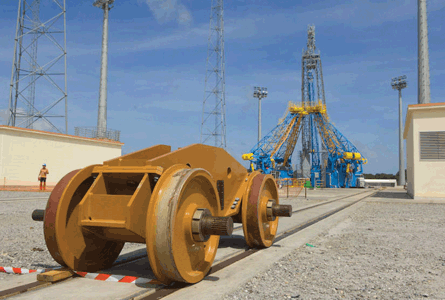For the past 40 years, Russia's cosmodromes in Baikonur and Plestesk have been home to the Samara Space Center's Soyuz launcher, but from next year, South America will play host to the world's most frequently launched rocket.
In July 2010, the flight of a Soyuz 2-1a from French Guiana will be the first use of a Russian rocket outside European Russia or a former Soviet state. French Guiana was studied as a Soyuz launch site in the 1990s. Its equatorial location enables the rocket to place 3,000kg (6,600lb) into geostationary orbit, compared with 1,800kg from Baikonur.
 |
|---|
© ArianespaceA mobile gantry bogie on its track which leads to the Soyuz launch pad |
Transported by ship from St Petersburg, the first two Samara Soyuz 2-1a rockets arrived in French Guiana on 23 November. By May 2010, the first of these will be moved to the assembly building for preparation.
A Soyuz history In 1963 the first Soyuz family rocket, produced by the Samara space centre in south-west Russia, was launched. Officially identified as Soyuz in 1966, Samara's rocket typically had three strap-on boosters, a core stage - which Western manufacturers would call a first stage - and an upper stage. Several Soyuz variants followed - the L, M, the U and its modification the U2, which went into operation in 1982. The M, U and latest "2" family versions have been launched from the Plesetsk cosmodrome in northern Russia. Today the Soyuz-U2 is used by the Russian government launching the Progress cargo vessel while a version of the original U, the FG, launched the manned Energia Soyuz spacecraft from 2000 to 2008. Since 2008 the Soyuz 2-1a, which is part of the "2" family that includes the 2-1b, has been used for launching Energia's TMA version of its manned Soyuz spacecraft from the Baikonur cosmodrome in Kazakhstan. The 2-1a was launched for the first time from Plesetsk in November 2004 and the 2-1b from Baikonur in December 2006. The "2" family introduced a digital control system, a digital telemetry radio and engine improvements throughout. There are plans for a Soyuz 2-3 that will have a low Earth orbit payload capability of 10,000kg (22,000lb) and a less-capable Soyuz 1 that can lift 2,800kg to LEO using a core module powered by one engine and no strap-on boosters.
|
The Soyuz launch complex in French Guiana is in the municipality of Sinnamary and is largely a replica of Baikonur.
Next year will see three Soyuz launches, two of 2-1a and one of 2-1b. The July launch is for UK-based Avanti Communications' Hylas satellite. October will see France's Pleiades orbited and the third launch, in November, will be for the first two Galileo satellite navigation satellites. For their orbit, they need the Soyuz 2-1b with its better upper stage.
The planned launch rate is four a year and the minimum lifespan for Sinnamary is 15 years. The site differs from Baikonur in having a mobile gantry - the tower that protects the rocket from weather. Its assembly has begun.
Delays with the gantry's development and other problems, including having to dynamite granite for the flame trench, have been blamed for the two-year delay. Scheduled to fly in 2008 and originally costed in 2002 at €344 million, including a €121 million investment by Arianespace, the delay has pushed the final bill up to €405 million, also in 2002 euros. It had been rescheduled for an April 2009 launch, but in June this year the Italian space agency confirmed the delay to 2010.
Arianespace says Sinnamary launches cost €70 million ($105 million), while Baikonur launches are marketed by the company's Russian venture, Starsem.
Despite no Russian announcements about commercial launches from its planned far eastern cosmodrome, Vostochny, Baikonur and Sinnamary may get competition from the new site, which could be a public/private venture. At an investment conference in October, the Amur region's governor said investors from China, Japan and the Republic of Korea were interested. Funded mostly by the Russian government funded, research for Vostochny's construction began in 2008. According to Russia's Federal Space Agency, it will cost Rb400 billion ($13.86 billion).
It is planned to replace Baikonur, for which Russia pays Kazakhstan $115 million a year, which suggests Vostochny will have a commercial role. Employing 20,000 people, it will occupy 550km2 and is reached by the Chita-Khabarovsk highway, the trans-Siberian railway or its 4,500m (14,700ft) runway.
Vostochny and Sinnamary may both also see human spaceflight. After 2015, Vostochny will launch the new Russian manned spacecraft, and France's space minister said in October that French Guiana could launch astronauts for exploration. They would use the Soyuz-FG launched Energia Soyuz TMA spacecraft.
The European Space Agency's Soyuz manager, Didier Coulon, sees no problems. "It's a very limited modification to the launch pad and we need a clean room for the astronaut preparation."
Source: Flight International


























